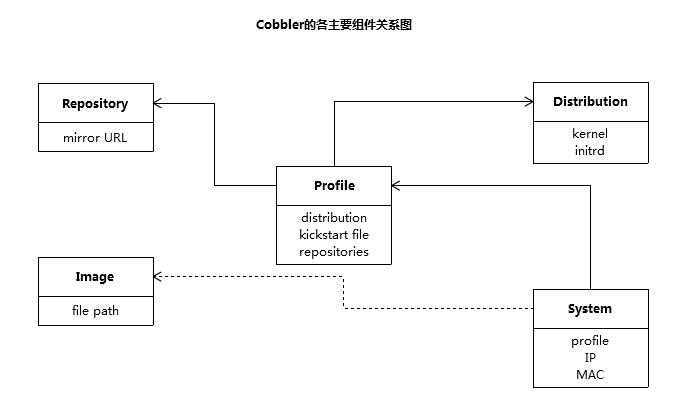Cobbler自动化部署最佳实践
Posted oldxulinux
tags:
篇首语:本文由小常识网(cha138.com)小编为大家整理,主要介绍了Cobbler自动化部署最佳实践相关的知识,希望对你有一定的参考价值。
第1章 Cobbler自动化部署最佳实践
运维自动化在生产环境中占据着举足轻重的地位,尤其是面对几百台,几千台甚至几万台的服务器时,仅仅是安装操作系统,如果不通过自动化来完成,根本是不可想象的。
面对生产环境中不同服务器的需求,该如何实现批量部署多版本的操作系统呢?Cobbler便可以的满足这一实际需求,实现多版本操作系统批量部署。
笔者QQ:572891887
Linux架构交流群:471443208
1.1 Cobbler简介
Cobbler是一个快速网络安装linux的服务,而且在经过调整也可以支持网络安装windows。该工具使用python开发,小巧轻便(才15k行python代码),使用简单的命令即可完成PXE网络安装环境的配置,同时还可以管理DHCP、DNS、TFTP、RSYNC以及yum仓库、构造系统ISO镜像。
Cobbler支持命令行管理,web界面管理,还提供了API接口,可以方便二次开发使用。
Cobbler客户端Koan支持虚拟机安装和操作系统重新安装,使重装系统更便捷。
Cobbler各个组件之间关系

cobbler各主要组件关系图
distro->profile-system(可选)
distro 发行版
面对不同的操作系统
面对同一个操作系统不同的版本
profile
核心特性是通过kickstart来部署
system
主要目的配置网络接口
1.2 Cobbler功能
使用
Cobbler,您无需进行人工干预即可安装机器。Cobbler 设置一个 PXE 引导环境(它还可使用 yaboot 支持 PowerPC),并控制与安装相关的所有方面,比如网络引导服务(DHCP 和 TFTP)与存储库镜像。当希望安装一台新机器时,Cobbler 可以:
使用一个以前定义的模板来配置 DHCP 服务(如果启用了管理 DHCP)
将一个存储库(yum
或 rsync)建立镜像或解压缩一个媒介,以注册一个新操作系统
在 DHCP 配置文件中为需要安装的机器创建一个条目,并使用您指定的参数(IP 和 MAC 地址)
在 TFTFP 服务目录下创建适当的 PXE 文件
重新启动 DHCP
服务以反映更改
重新启动机器以开始安装(如果电源管理已启用)
Cobbler 支持众多的发行版:Red
Hat、Fedora、CentOS、Debian、Ubuntu 和 SuSE。当添加一个操作系统(通常通过使用 ISO 文件)时,Cobbler 知道如何解压缩合适的文件并调整网络服务,以正确引导机器。
Cobbler 可使用
kickstart 模板。基于 Red Hat 或 Fedora 的系统使用 kickstart 文件来自动化安装流程。通过使用模板,您就会拥有基本的 kickstart 模板,然后定义如何针对一种配置文件或机器配置而替换其中的变量。例如,一个模板可能包含两个变量 $domain和 $machine_name。在 Cobbler 配置中,一个配置文件指定
domain=mydomain.com,并且每台使用该配置文件的机器在machine_name
变量中指定其名称。该配置文件中的所有机器都使用相同的 kickstart 安装且针对
domain=mydomain.com 进行配置,但每台机器拥有其自己的机器名称。您仍然可以使用 kickstart 模板在不同的域中安装其他机器并使用不同的机器名称。
为了协助管理系统,Cobbler
可通过 fence scripts 连接到各种电源管理环境。
Cobbler 支持 apc_snmp、bladecenter、bullpap、drac、ether_wake、ilo、integrity、ipmilan、ipmitool、lpar、rsa、virsh 和 wti。要重新安装一台机器,可运行 reboot system foo命令,而且 Cobbler 会使用必要的凭据和信息来为您运行恰当的 fence scripts(比如机器插槽数)。
除了这些特性,还可使用一个配置管理系统 (CMS)。您有两种选择:该工具内的一个内部系统,或者集成一个现有的外部 CMS,比如 Chef 或 Puppet。借助内部系统,您可以指定文件模板,这些模板会依据配置参数进行处理(与 kickstart 模板的处理方式一样),然后复制到您指定的位置。如果必须自动将配置文件部署到特定机器,那么此功能很有用。
使用 koan 客户端,Cobbler 可从客户端配置虚拟机并重新安装系统。我不会讨论配置管理和koan 特性,因为它们不属于本文的介绍范畴。但是,它们是值得研究的有用特性
1.3 基础环境准备
[root@cobbler-node1
~]# cat /etc/redhat-release #系统版本
CentOS
Linux release 7.1.1503 (Core)
[root@cobbler-node1
~]# uname –r #内核版本
3.10.0-229.el7.x86_64
[root@cobbler-node1
~]# getenforce #检测selinux是否关闭(必须关闭)
Disabled
[root@cobbler-node1
~]# systemctl stop firewalld #关闭防火墙
[root@cobbler-node1
~]# ifconfig eth0|awk -F \'[ :]+\' \'NR==2 {print $3}\' #查看IP地址
10.0.0.101
[root@cobbler-node1
~]# hostname #查看主机名
cobbler-node1
[root@cobbler-node1
~]# wget -O /etc/yum.repos.d/epel.repo http://mirrors.aliyun.com/repo/epel-7.repo #cobbler安装必须使用到epel源
提示:
虚拟机网卡采用NAT模式,因为我们会搭建DHCP服务器,在同一局域网多个DHCP服务会有冲突,并且导致实践失败。
1.4 安装Cobbler
[root@cobbler-node1
~]# yum install cobbler cobbler-web pykickstart httpd
cobbler
#cobbler程序包
cobbler-web
#cobbler的web服务包
pykickstart
#cobbler检查kickstart语法错误
httpd #Apache web服务
/etc/cobbler # 配置文件目录
/etc/cobbler/settings # cobbler主配置文件
/etc/cobbler/dhcp.template # DHCP服务的配置模板
/etc/cobbler/tftpd.template
# tftp服务的配置模板
/etc/cobbler/rsync.template
# rsync服务的配置模板
/etc/cobbler/iso # iso模板配置文件目录
/etc/cobbler/pxe # pxe模板文件目录
/etc/cobbler/power # 电源的配置文件目录
/etc/cobbler/users.conf # Web服务授权配置文件
/etc/cobbler/users.digest # web访问的用户名密码配置文件
/etc/cobbler/dnsmasq.template # DNS服务的配置模板
/etc/cobbler/modules.conf # Cobbler模块配置文件
/var/lib/cobbler # Cobbler数据目录
/var/lib/cobbler/config # 配置文件
/var/lib/cobbler/kickstarts
# 默认存放kickstart文件
/var/lib/cobbler/loaders # 存放的各种引导程序
/var/www/cobbler # 系统安装镜像目录
/var/www/cobbler/ks_mirror # 导入的系统镜像列表
/var/www/cobbler/images # 导入的系统镜像启动文件
/var/www/cobbler/repo_mirror # yum源存储目录
/var/log/cobbler # 日志目录
/var/log/cobbler/install.log # 客户端系统安装日志
/var/log/cobbler/cobbler.log # cobbler日志
1.5 检测Cobbler
cobbler的运行依赖于dhcp、tftp、rsync及dns服务,其中dhcp可由dhcpd(isc)提供,也可由dnsmasq提供;tftp可由tftp-server程序包提供,也可由cobbler功能提供,rsync有rsync程序包提供,dns可由bind提供,也可由dnsmasq提供
cobbler可自行管理这些服务中的部分甚至是全部,但需要配置/etc/cobbler/settings文件中的“manange_dhcp”、“manager_tftpd”、“manager_rsync”、“manager_dns”分别来进行定义,另外,由于各种服务都有着不同的实现方式,如若需要进行自定义,需要通过修改/etc/cobbler/modules.conf配置文件中各服务的模块参数的值来实现。
[root@cobbler-node1
~]# systemctl start httpd #启动apache服务
[root@cobbler-node1
~]# systemctl start cobblerd #启动cobbler程序
检查配置文件,需要在cobblerd和httpd启动的情况下检查
[root@cobbler-node1
~]# cobbler check #检查存在的问题,逐一解决
The
following are potential configuration items that you may want to fix:
1 :
The \'server\' field in /etc/cobbler/settings must be set to something other than
localhost, or kickstarting features will not work. This should be a resolvable hostname or IP
for the boot server as reachable by all machines that will use it.
2 :
For PXE to be functional, the \'next_server\' field in /etc/cobbler/settings must
be set to something other than 127.0.0.1, and should match the IP of the boot
server on the PXE network.
3 :
change \'disable\' to \'no\' in /etc/xinetd.d/tftp
4 :
some network boot-loaders are missing from /var/lib/cobbler/loaders, you may
run \'cobbler get-loaders\' to download them, or, if you only want to handle
x86/x86_64 netbooting, you may ensure that you have installed a *recent* version
of the syslinux package installed and can ignore this message entirely. Files in this directory, should you want to
support all architectures, should include pxelinux.0, menu.c32, elilo.efi, and
yaboot. The \'cobbler get-loaders\' command is the easiest way to resolve these
requirements.
5 :
enable and start rsyncd.service with systemctl
6 :
debmirror package is not installed, it will be required to manage debian
deployments and repositories
7 :
The default password used by the sample templates for newly installed machines
(default_password_crypted in /etc/cobbler/settings) is still set to \'cobbler\'
and should be changed, try: "openssl passwd -1 -salt \'random-phrase-here\'
\'your-password-here\'" to generate new one
8 :
fencing tools were not found, and are required to use the (optional) power
management features. install cman or fence-agents to use them
以上是关于Cobbler自动化部署最佳实践的主要内容,如果未能解决你的问题,请参考以下文章